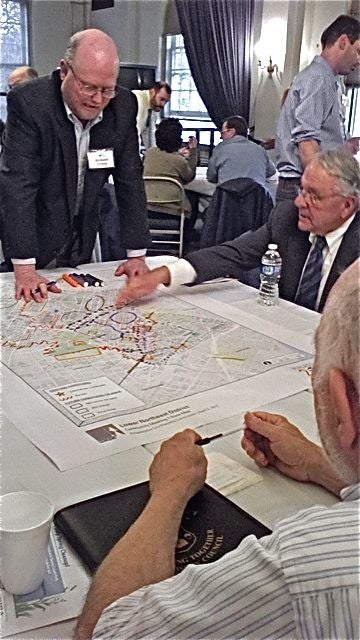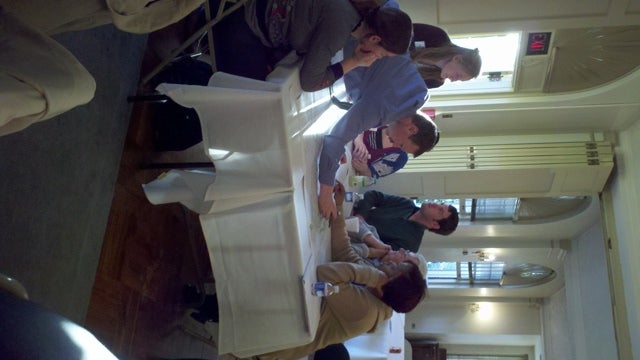First steps taken toward a comprehensive plan for the Lower Northeast
Two roadways were on the minds of residents who participated in a public input session designed to help city planners map out the future of Lower Northeast Philadelphia.
Participants want Roosevelt Boulevard to be easier to walk across or drive on, and they want a safer and more prosperous Frankford Avenue.
Roosevelt Boulevard “is the main artery through the Northeast, and it is not very user-friendly,” said Joe Krause, who lives in Northwood.
Just adding more lighting on Frankford Avenue would make it safer at night, said Frankford Civic President Pete Specos. And “we hope to bring businesses back.”
The Tuesday night discussion at Friends Hospital was the first of three public sessions during the development of the Lower Northeast District Plan, which when finished will be one of 18 district-level portions of the city’s new comprehensive plan, Philadelphia 2035.
Lower Northeast includes the neighborhoods of Frankford, Northwood, Oxford Circle, Summerdale and Lawncrest.
District plans will shape neighborhoods by setting goals for future development and making recommendations for zoning changes, city-owned land and facilities and public investment. The first two district plans, for West Park and Lower South, were recently adopted by the city planning commission.
Community planner and Project Manager Ian Litwin got the evening started with a presentation on current conditions in the Lower Northeast. Between the 1990 Census and the 2010 Census, the population in the district increased by 11 percent, making it one of the fastest-growing portions of the city. The population growth increased without a corresponding increase in housing units – the number of people living in each household increased, he said.
During that same period, there was a decrease in home ownership and an increase in the poverty rate, Litwin said.
The district is getting younger, with 35 percent of residents under the age of 20.
While in the past the area was a keymanufacturing job center, it is now largely a bedroom community, he said. Still, there are 25,000 jobs here – four percent of the city total. Of the 35,000 workers who live here, just 2,000 work in the district. The rest travel elsewhere for work, and people who live elsewhere fill most of the local jobs. The unemployment rate is higher than average: 15 percent.
After hearing the overview, participants discussed current conditions and future goals of the area at the tables where they were seated. Planning Commission staff took notes and drew their comments and ideas on a map of the district.
“Everyone thinks of the Northeast as being car-reliant, but people at my table said they would walk more if there were more destinations to get to on foot,” said Healthy Communities Coordinator Clint Randall.
Jennifer Folks, who lives in Northwood on the Frankford border, said she used to take the Market-Frankford El almost exclusively, but her husband, Sloane, urged her to take her car at night instead for safety’s sake.
Both Folks would like to see the old industrial buildings of Frankford adaptively reused for a new purpose. “I know in some cases, that’s too expensive, but where possible,” Sloane Folks added. Buildings too expensive to repair should be torn down. Some green space would be nice, he said.
Jennifer Folks said that some large properties that were once grand mansions are now being used as single-room-occupancy dwellings, and some are nuisances that she would like to see gone. Some bill themselves as rehabs, she said, but only at a few is there any evidence that those living there are actually getting help.
In addition to talking about changes they would like to see, participants were asked what they would like to preserve. Parks and landmarks made the list – including the Friends Hospital, well-known for its landscaping and architecture. So did Northwood’s long-standing deed restrictions, which restrict properties to owner-occupied homes only. There can be no multi-family dwellings, nor can any existing houses be rented, nor can any commercial or industrial operations exist, said Al Stuhl of Northwood Civic. The restriction, which has been upheld in the courts, must remain, he said. “It protects the character of our neighborhood.”
At the second Lower Northeast session, which will be held sometime in June, city planners will present a summary of the ideas presented this week. A third session will be held in August, and the goal is to have the plan adopted by the planning commission in October.
Reach the reporter at kgates@planphilly.com.
WHYY is your source for fact-based, in-depth journalism and information. As a nonprofit organization, we rely on financial support from readers like you. Please give today.





